![]()
For the Detroit Red Wings, goaltending appeared to be the lone bright spot on their roster heading into the season. And “bright” may be a bit of a reach.
If the Red Wings are going to have any success, Jimmy Howard and Jonathan Bernier will need to carry the team behind an inexperienced or regressing defensive unit and an offensively starved forward group.
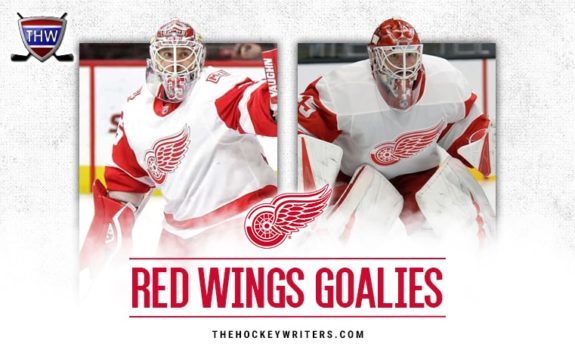
Ten games into the 2018-19 season, how have things looked in net for Detroit? Have Howard and Bernier held up their end of the bargain?
Related: 5 Keys to Red Wings 2018-19 Success
Using goaltending guru Mitch Korn’s three goal categories—should have had, could have had, and no chance—we can evaluate Detroit’s netminders based on the goals that they’ve allowed. Before digging in, here’s a quick explanation of the categories:
- Should have had – The goalie should have stopped the puck, but didn’t. Not a great goal to allow.
- Could have had – If the goalie did something differently, there’s a chance he could have stopped the puck.
- No chance – The goalie got hung out to dry and had zero chance to make a play on the puck. Good goal and not his fault at all.
Okay, now we’ll dive into Howard and Bernier’s play.
Howard: Game 1 vs. Columbus
Goal 1 (Cam Atkinson): Could have had.
Goal 2 (Josh Anderson): No chance.
Goal 3 (Artemi Panarin): Could have had.
All three goals came from high-danger scoring areas as a result of poor team defense. On Atkinson’s power play goal, Howard was slightly screened from the top-of-the-circle shot, but did not get much depth to get around the screen. For the next goal, he had no chance at all – there’s not much a goalie can do on a third rebound with a defenseman and opposing player on top of him and no one else around to clean up the trash.
Finally, on Panarin’s overtime tally, the Russian sniper blew a wrist shot past Howard from the circle, but Detroit’s netminder arguably should have stopped it. Panarin can certainly rip it with the best of them, but Howard had a clear line of sight to the puck, which was about 20 feet away.
Bernier: Game 2 vs. Los Angeles
Goal 1 (Anze Kopitar): Should have had.
Goal 2 (Paul LaDue): Should have had.
Goal 3 (Alex Iafallo): Could have had.
Goal 4 (Iafallo): Empty net.
Remember in D3: The Mighty Ducks when Coach Orion put Charlie Conway on defense and taught him to allow the forward to make the first move before reacting? The same logic applies to goaltenders, and on both Kopitar and LaDue’s goals, Bernier wrongly made the first move on what were stoppable shots.
The third goal was a complete disaster from start to finish. The miscommunication between Bernier and Libor Sulak was ugly. Threading a pass between Dylan Larkin and Nick Jensen was worse. Many things could have prevented the goal, but Bernier didn’t have much of a chance on the shot. He’ll get the in-between grade for that one.
Howard: Game 3 vs. Anaheim
Goal 1 (Hampus Lindholm): Could have had.
Goal 2 (Jakob Silfverberg): No chance.
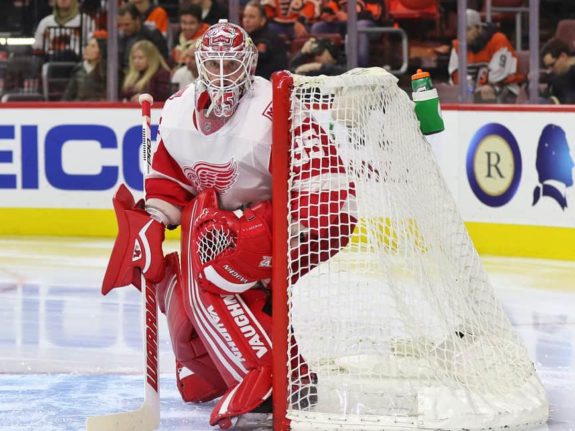
There was a lot of ugly on Anaheim’s first goal. Sound familiar? Anthony Mantha let Lindholm walk by him with little forecheck. Joe Hicketts screened Howard a bit and the shot deflected up off his skate. But Howard still arguably could have made the save. He had already committed to the short side post when there was more of a screen in front, leaving the far side wide open. If Howard had stayed square, then the puck would have hit him in the chest.
The second goal in this game was almost a carbon copy of the second goal in the Columbus matchup. Weak defense allowed the Ducks to drive the net, two defensemen overskated with the initial attacker, and no one was home to clean up in front with Howard down from the first shot. No chance for Detroit’s netminder.
Related: Top 3 All-Time Red Wings Goalies
Howard: Game 4 vs. Toronto
Goal 1 (Morgan Rielly): Could have had.
Goal 2 (Mitch Marner): No chance.
Goal 3 (Auston Matthews): Should have had.
Goal 4 (Auston Matthews): No chance.
Goal 5 (Ron Hainsey): Empty net.
Detroit’s inexperience and lack of execution truly showed against the high-powered Maple Leafs (Yes, you read that correctly). Toronto’s first goal was a prime example – absolutely brutal on Detroit’s part.
Upon further review, Howard could have given himself a better chance to stop Morgan Rielly’s three-on-one blast. He got over in time for the shot, just not enough of his body was set in position. Instead of sliding across, Howard could have pushed and remained standing and gotten square to the shot. This could have been enough to get a piece of the puck and save Detroit’s defense after they left him out to dry.
Inexperience also played into Marner’s goal and Matthews’ second tally. Both were backdoor goals where the Red Wings left a man open for an easy tap in.
The only goal that Howard should have had was Matthews’ first power play marker. He had a clear line of sight to the puck and plenty of time to either get depth or react to the shot.
Bernier: Game 5 vs. Boston
Goal 1 (David Pastrnak): Should have had.
Goal 2 (Charlie McAvoy): No chance.
Goal 3 (Jake DeBrusk): Could have had.
Goal 4 (Pastrnak): Could have had.
Goal 5 (Pastrnak): No chance.
Goal 6 (Anders Bjork): Should have had.
Goal 7 (DeBrusk): No chance.
Goal 8 (Sean Kuraly): Should have had.
No need for goal-by-goal analysis here – all facets from this game were ugly. There were some concerning aspects of Bernier’s game, though.
It’s true that the Red Wings did not help their netminder out much, but he also tended to drop down early when the play was in close. This occurred on the fourth, seventh, and eighth goals, regardless of Bernier’s ability to stop the eventual scoring shot.
He didn’t move well to his blocker side, either. Better pushes to Bernier’s right side could have helped him get a piece of the fourth, fifth, and seventh shots. Considering Detroit’s defensive woes, Bernier will need to improve his lateral movement to give them a chance in his next starts.
Howard/Bernier: Game 6 vs. Montreal
Goal 1 (Jonathan Drouin): Could have had.
Goal 2 (Tomas Plekanec): Should have had.
Goal 3 (Tomas Tatar): No chance.
Goal 4 (Brendan Gallagher): No chance.
Goal 5 (Charles Hudon): No chance.
Goal 6 (Drouin): Could have had.
Goal 7 (Paul Byron): No chance.
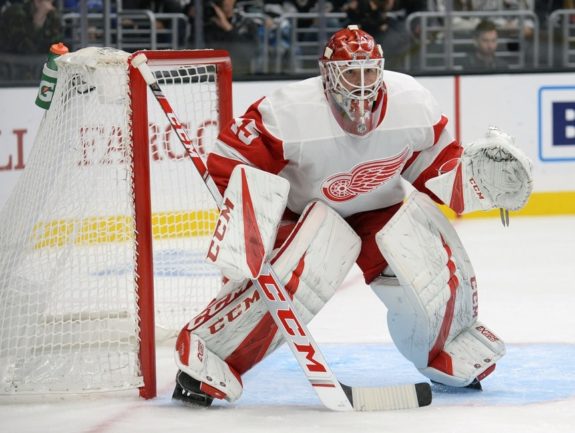
Another ugly game, but less blame on Detroit’s goaltender(s).
Howard started off the game under siege and had to face a Drouin penalty shot early on. Montreal’s forward had a nice shot to open the scoring, but Howard was also off his angle – it appeared that he squared up to the shooter’s body rather than the puck and left the far side open. And after not being aggressive on the puck, Howard was overly aggressive on Plekanec’s fluky goal. There’s no reason to come out that far on such a bad shooting angle.
Those two goals aside, Howard played well. He got hung out to dry on the next three markers before giving way to Bernier, who gave up a juicy rebound that led to Drouin’s second goal of the night. Had he held onto the puck or directed it to the corner, Montreal may not have scored on that sequence.
Or maybe they would have, as the Red Wings left Byron wide open at the top of the crease for an easy goal later on.
Howard: Game 7 vs. Tampa Bay
Goal 1 (Brayden Point): No chance.
Goal 2 (Steven Stamkos): No chance.
Goal 3 (Alex Killorn): Empty net.
Visiting a strong Lightning team, Howard played much better than he did in his previous two outings. Neither of the two goals scored were his fault – Point’s goal was a lucky skate redirection off of a centering pass and there’s not much anyone can do against a wide-open Stamkos 12 feet out.
Individually, Howard looked motivated to end the losing streak that night. He moved well laterally and did a great job of anticipating plays. But once again, Howard is starting to look like the Jacob deGrom of the NHL.
Howard: Game 8 vs. Florida
Goal 1 (Keith Yandle): Should have had.
Goal 2 (Nick Bjugstad): Could have had.
Goal 3 (Mike Hoffman): Should have had.
Though the Red Wings won (finally), this was not Howard’s night. He made some excellent saves here and there, but the goals against were pretty ugly.
On Yandle’s far-side wrister, Howard just missed the puck and let by a shot he normally stops. Maybe the shot surprised him – he might have expected Yandle to walk in closer. Definitely one he’d like to have back, though.
The next two goals both went low blocker and seemed harmless until they were in the back of the net. It’s possible that Howard didn’t pick up Bjugstad’s shot until it was already on its way – there was a bit of a screen off the faceoff. However, he was pretty deep in the net and could have benefited from gaining some depth. Hoffman’s goal was similar—minus the screen—and Howard flat-out missed an easy save.
NHL games can be odd. On a night when Howard was not on his A-game, didn’t challenge the shooters as much as he normally does, and let in three weak goals, the winless Red Wings take home their first victory of the season. If Detroit can combine Howard’s goaltending from the Tampa Bay game with their resilience and scoring from the Panthers matchup, then they’ll be a tougher team to play against.
Howard: Game 9 vs. Carolina
Goal 1 (Justin Faulk): No chance.
Goal 2 (Michael Ferland): No chance.
Goal 3 (Jordan Martinook): Empty net.
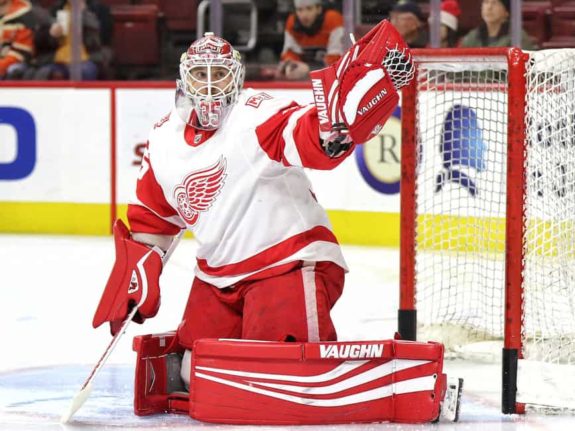
Once again under siege, Howard couldn’t have done much to prevent the two goals that were scored against him versus Carolina. Faulk’s power play blast evaded a myriad of players, including a couple Red Wings who opted not to block the shot. Howard had no way of tracking it through so many bodies.
The next tally—Ferland’s power play goal—was the result of a bad penalty, Detroit’s killers watching the puck move around them, and a wide open player just outside the crease with a clear passing lane leading to his stick. There’s not much Howard could have done on that point-blank shot.
Other than those two goals, Detroit’s netminder stopped everything that he should have, which was quite a bit against the high-flying Hurricanes. It was a nice bounce-back game for Howard, despite taking yet another loss.
Howard: Game 10 vs. Winnipeg
Goal 1 (Kyle Connor): No chance.
Goal 2 (Dustin Byfuglien): Could have stopped.
Building off of a stellar game against Carolina, Howard stood tall against a barrage of Winnipeg shots. On the Jets’ third power play of the second period (yes, the third full power play in one period), a lucky bounce ended up on the stick of Connor, who stashed it home. Howard really could not do much on the goal considering that particular sequence of events included a stopped shot from in close, a quick centering pass, and his defense simply watching the puck the whole time.
Byfuglien’s goal was similar, but at least Howard had a chance to stop it. Once again, Detroit’s skaters appeared to play a passive defense as Winnipeg passed the puck around the offensive zone and found a seam for Byfuglien to walk in from the point. It took a great shot to beat Howard, but if the netminder was an inch or two closer to the shooter, his shoulder would have caught at least some of the puck and prevented a goal. That, and Howard also made himself smaller than he needed to be in that instance.
Other than those two goals, Detroit’s No. 1 goaltender moved well around the net and made some spectacular saves after defensive breakdowns.
How Have the Red Wings Goalies Performed?
To get a sense of how Howard and Bernier have played in the Red Wings’ crease, let’s compare their goals against to that of Washington’s Braden Holtby. Not only did the Capitals’ netminder take home the Stanley Cup last season, he’s also the most recent long-term prodigy of Mitch Korn, who developed this assessment method.
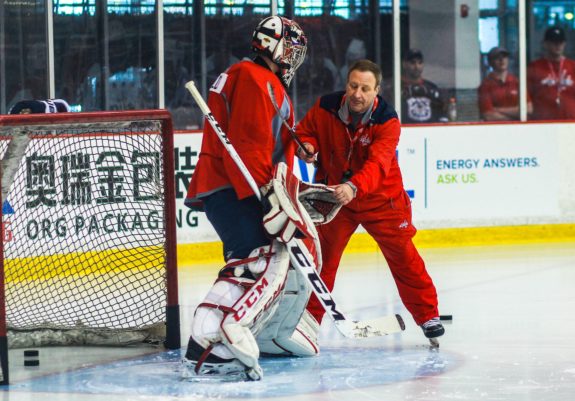
(Korn left Washington this summer to join Barry Trotz and the New York Islanders, and has only worked with their goaltenders for a short amount of time.)
| Goalie | GP | Should Have Had | Could Have Had | No Chance | Total |
| Jimmy Howard | 8 | 4 (17%) | 7 (30%) | 12 (52%) | 23 |
| Jonathan Bernier | 3 | 5 (38%) | 4 (31%) | 4 (31%) | 13 |
| Red Wings Total | 6 | 9 (25%) | 11 (31%) | 16 (44%) | 36 |
| Braden Holtby | 8 | 4 (16%) | 5 (20%) | 16 (64%) | 25 |
There’s good news and bad news here. The good news is that Howard has played similarly to Holtby in terms of goals against. The bad news is that Washington’s goalie hasn’t been spectacular for the defending champions.
However, Howard has improved his play as of late. His outings against Tampa Bay, Carolina, and Winnipeg would certainly be considered quality starts, despite the accompanying losses.
Bernier on the other hand, did not open up the season well with his new team. But at least there’s time for improvement. In the 11th game of the season (not part of this analysis), Bernier turned in a terrific outing versus the Stars and earned his first win as a Red Wing – also Detroit’s first regulation win of the 2018-19 campaign.
Overall, Howard’s play has been acceptable and Bernier’s could use some work. The Red Wings desperately need these two netminders to step up every night for the team to win. And though there are signs of improvement, it needs to be sustained rather than just be a fleeting moment of hope for Detroit.
Final Word
For my beer league team, one of my defensemen has a rule for me: three goals or less. If I succeed, we’ll probably win. If I let in more, we’ll probably lose. I have no idea what the success rate is, but I’m sure there’s a correlation.
It’s a similar scenario for the Red Wings and their netminders, but the rule is two or less. With the anemic offense still struggling to produce curly fries-worthy numbers, Howard and Bernier have little room for error. If they let in two or less goals, the Red Wings have a shot at winning. Anything more, they’ll be a little closer to landing the No. 1 overall draft pick this spring.